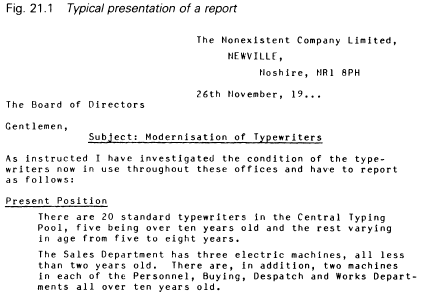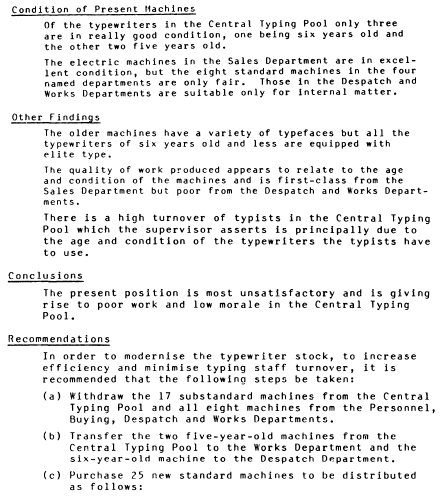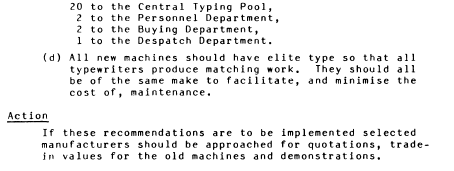According to the dictionary a report is ‘an account or opinion formally expressed, after investigation or consideration’. It will be seen from this definition that a report is considered to be formal and is required to give an account of the matter covered or to state an opinion on it. Sometimes both are required. Moreover, in most cases conclusions have to be drawn by the compiler and, often, recommendations given.
1. Kinds of Report
Generally speaking, there are two main kinds of report, though not every report will fall neatly into one or other of these categories.
The first is the individual report. This is usually expressed in the first person and is the kind used for internal routine reports and short reports on day-to-day matters. Examples of these are accident reports, organisation and method reports, sales reports and so on. In some cases, particularly where a great deal of statistical and other figure information is included, a standard form is used so that variable data only has to be entered in the same way as in a standard form letter.
The second type of report is the general report. This is more formal than the individual report and is generally written in the third person, though this is not always the case. Such reports are frequently composed for external or public circulation and are often quite voluminous. Official reports of this nature sometimes run into two or more volumes bound in book form, with extensive indexes.
2. Basic Rules in Report Writing
There are basic rules that underly all forms of report writing, which do two things. First they ensure the logical construction of the report and second they assist the writer to present the report in an accepted format. These rules may be summarised as follows:
- The report should have a title which should clearly indicate the subject matter covered.
- If for restricted circulation the report should be addressed to the person or persons intended to read and act upon it. A report written for public distribution is not so addressed, however.
- If addressed to a specific person or a specific body of people (a customer or a board of directors, for example) a report should normally begin with a salutation. This is not required if the report is a general one for public consumption, nor if it is a regular routine report.
- Any but a very brief informal report should begin with a statement of the terms of reference. This is not necessary with a routine report as these will have been laid down when the series was inaugurated.
- An introduction to the body of the report is usual; this presents the problem dealt with and, usually, states the authority under which the report was prepared. In the case of a very short report the introduction can incorporate the terms of reference.
- The body of the report should explain the nature of any investigations carried out. It should state precisely the facts discovered and put clearly and succinctly the arguments and opinions, if any, arising from the investigations and facts. Sections and paragraphs of the report should have headings and subheadings to aid the reader. In the longer form of report it is helpful if the various sections and paragraphs are numbered for easy reference.
- The conclusions of the writer or writers are normally required. Frequently, especially in technical reports, recommendations are called for. These should be stated separately from the body of the report and headed appropriately. Where recommendations are given it is frequently required that suggested action to put them into effect should also be stated: here again there should be an appropriate heading. Where the report is a very lengthy one conclusions and recommendations may be given at the ends of the relevant sections. In these cases the separate topics should have chapters of their own.
- Reports should be signed and dated. Where the report is the work of a committee or other group the signature is usually that of the chairman. In any case, the description of the person signing should be given.
- Whenever the report is of a meeting the names of those present should be given at the head. Similarly, if the report is the result of a joint effort by several people, or of a committee, the names of those taking part should be given.
- Frequently parts of a report will be supported by graphs, tables of statistics and other similar data, and where to place them within the report sometimes poses a problem. It is usually recommended that such matter form an appendix or appendices and this is commonly done. The guide should be the ease with which the report can be read and how immediate reference to the data should be. Sometimes the need constantly to turn to the back of a lengthy report for references can make reading irritating or difficult, in which case it may be preferable to have the supporting data adjacent to the matter it supports. This is a matter of judgement when the report is being prepared.
- A lengthy report should always be accompanied by a table of contents to make reference to specific topics as easy as possible.
3. Planning and Writing a Report
In order that a report may fulfil its purpose it is necessary for the writer to know for whom it is intended and why it is required. This information will help the author to decide which parts of the matter collected should be included in the report and which can be omitted. For example, if a report is required about a possible replacement machine for the factory, the board of directors will be interested in different data from that required by the production manager or the maintenance engineer.
Similarly, the language in which the report is written will be different according to who is to use it. Highly technical language will be expected by the production manager or the maintenance engineer; it would probably be quite inappropriate for the board of directors.
The terms of reference will give the ground to be covered by the report and in no case should these be exceeded. It sometimes happens that during the course of investigations something is brought to light that is outside the scope of the terms of reference but is, nevertheless, considered to be of importance. In such a case a supplementary communication should be raised and passed on to the appropriate authority independently of the report.
When planning a report it is essential that the date it is required should be known to the writer. This date must be met without fail. However good a report, it is valueless unless it is ready when needed.
A report should flow logically from one point to another and should develop in an orderly and easily understood fashion. In achieving this it is helpful if the headings and subheadings are laid down first. This provides a skeleton framework around which the report can be written with the confident knowledge that a logical arrangement has been established. In addition, this practice helps to ensure that no important points are accidentally overlooked.
The style in which a report is written is important. It should be authoritative. Positive statements should be used wherever possible and sentences kept short. Negative statements should be avoided as far as possible, particularly if the report is required to stimulate action. Positive statements encourage positive attitudes, whereas negative statements are inclined to discourage them.
For any report but a brief one it is almost always necessary to prepare a draft first, which can be carefully edited before being produced in its final form. In the case of lengthy reports several drafts may be necessary which are carefully edited and re-edited before a satisfactory final result is achieved. Where the report is to contain any statements or opinions by experts it is essential to have these verified by the experts concerned, particularly in the context in which they are to appear.
The presentation of a report in its final form will depend upon its length, the number of copies required and upon the impression it seeks to present. It may, therefore, be typewritten, duplicated or printed. A long, formal report will normally be printed and bound in book form. A short, informal one may be duplicated and stapled together. A report designed to impress a potential customer may be carefully typed and bound in an attractive cover by means of one of the binding devices commonly found in the modern office. Presentation is, then, a matter of length, number and for whom.
4. A specimen report
Figure 21.1 illustrates a specimen of a short, formal report. Examples of long, official reports are held by most public libraries and these may be seen on request of the librarian.



Source: Eyre E. C. (1989), Office Administration, Palgrave Macmillan.

This site can be a stroll-via for the entire information you needed about this and didn’t know who to ask. Glimpse right here, and you’ll undoubtedly uncover it.